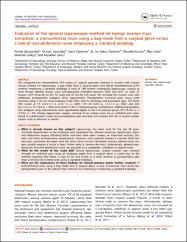Evaluation of the optimal laparoscopic method for benign ovarian mass extraction: a transumbilical route using a bag made from a surgical glove versus a lateral transabdominal route employing a standard endobag

Göster/
Tarih
2020Yazar
Güngördük, KemalAsicioglu, Osman
Gulseren, Varol
Ozdemir, Isa Aykut
Kocaer, Mustafa
Cakir, Ilker
Sanci, Muzaffer
Gokcu, Mehmet
Üst veri
Tüm öğe kaydını gösterÖzet
We compared two transumbilical (TU) routes of surgical specimen retrieval in women with ovarian masses treated via laparoscopy: a bag made from a surgical glove and lateral transabdominal (LTA) retrieval employing a standard endobag. A total of 109 women undergoing laparoscopic surgery to treat benign adnexal masses were retrospectively evaluated between 2014 and 2017. In total, 57 masses were removed via the TU route and 52 via the LTA route. We recorded the ovarian mass size; additional postoperative analgesic drug requirements. Postoperative incisional pain scores were assessed using a 10-cm visual analogue scale (VAS), time to discharge and procedure type. The mean VAS scores at 1h (5.0 +/- 1.7 vs. 6.3 +/- 1.3; p <.001); 12h (0.7 +/- 0.8 vs. 1.2 +/- 1.1; p=.004); and 24 h (0.1 +/- 0.3 vs. 0.7 +/- 0.6; p < .001) were lower in the TU-removal group. Furthermore, additional postoperative analgesic drug requirements were significantly higher in the LTA-removal group (10 (19.2%) vs. 3 (5.3%); p(-).03). During laparoscopic surgery, removal of an ovarian mass via an umbilical port (compared to a lateral port) causes less postoperative pain and does not increase the risk of wound complications such as infection or hernia.Impact statementWhat is already known on this subject? Laparoscopy has been used for the last 30 years. Constant improvement in the technique and equipment has allowed extensive, laparoscopic pelvic and abdominal surgery affording better outcomes than open surgery, an improved recovery, less pain, and fewer postoperative complications. However, mass removal remains a concern. Most laparoscopic specimens are larger than the initial trocar incision. Minimally invasive, adnexal mass surgery usually requires a trocar at least 10mm wide to remove the mass. Alternatively, adnexal mass extraction from the abdominal cavity can proceed via a suprapubic, umbilical, or vaginal route.What do the results of this study add? During laparoscopic surgery, ovarian mass removal through an umbilical port using an endobag made from a surgical glove is useful due to the method requiring little funds, is easy to do, and results in a lower amount of postoperative pain than a removal via a lateral port using a standard endobag.What are the implications of these findings for clinical practice and/or further research? A transumbilical route using a bag made from a surgical glove is easy, economical, and causes less postoperative pain to the patient than removal via a lateral port employing a standard endobag.

















